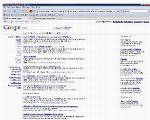Many companies run A/B tests to evaluate their design changes. An A/B test means that they have multiple products/designs being used by people on a day-to-day basis. One group is the control A and the other group is testing the new design, B. By tracking statistics of both groups you can quantify change between the two.
Recently one of my computers was tagged to view a re-design of Google results page:
The change creates a left hand gutter that has two core functions.
- It allows users to change Google search contexts, from web to images, to patents, blogs, Google Scholar and more.
- It allows users to refine search queries with other related queries.
The ability to change search contexts is useful however the functionality is redundant with the links that are already there in today's design. Running the links vertically may be advantageous in quickly reading and presenting a longer list. As Google's properties grow this may become more of a necessity. Ultimately I think this approach is flawed. As media gets separated into more and more buckets users will be forced to search for content on various properties. Wasn't the whole point of search to bring things together into one result set? I would love to see a single result list that would allow me to filter down by media type rather then having to make the choice up front. (Google Desktop takes this approach)
The ability to refine a search is somewhat useful. It helps identify similar and related searches. I'm reminded of the Ask.com commercial where a guy shows how Ask.com is a pimped out search engine. From some experimentation it seems that these related searches are showing other large numbered searches, not concepts. This means that this feature will help users refine down but won't help if the search is too narrow. There are many potential tools to refine searches by organizing data in a logical way. Currently the redesign continues to promote textual refinements rather then exposing tools on the results page to filter results by date, size, author, type, etc, etc.
The real question for me is what metric is Google using to evaluate the A/B test? Are they looking at page views, Ad conversions, number of executed searches or something else. The A/B testing metric is what will ultimately determine if this design is released.
